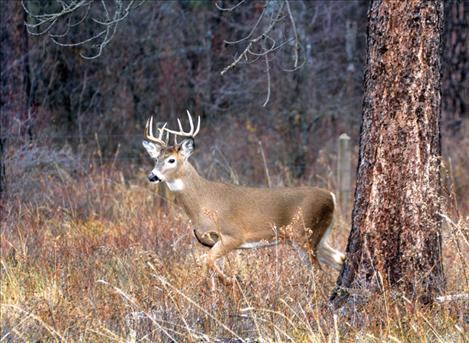Whitetail population up, wolf harvest down
Hey savvy news reader! Thanks for choosing local.
You are now reading
1 of 3 free articles.
As the 2012 hunting season drew to a close, Montana Fish, Wildlife and Parks officials were hopeful that whitetail deer populations may be on the rise.
“We’re cautiously optimistic that the whitetail deer population is increasing again in our area of northwest Montana,” said FWP communication education program officer John Fraley.
According to a press release, six Northwest Montana check stations located throughout the region are tasked with creating a representative sample of the area’s harvest. More complete data will be available after the telephone hunter surveys are conducted next spring.
The 2012 season saw a total of 17,635 hunters — down 5 percent from last year. These hunters claimed 941 whitetail deer, 131 mule deer and 78 elk through the course of the season. These numbers culminated in a hunter with game rate of 6.5 percent, slightly higher than last year’s 6.1 percent.
“We saw a good increase in the number of whitetail bucks as compared to last year,” Fraley said. “Ten percent more bucks than last year, and many were young bucks, so that tells us that the population is moving in the right direction.”
Hunters also checked 27 percent more mule deer than last year.
Fraley said FWP uses the whitetail buck harvest as a barometer to judge the health and size of the population, as these animals are consistently open to general hunting from year to year.
While deer populations are still down overall, FWP Wildlife Manager Jim Williams believes there are several signs that whitetail numbers are increasing.
According to the press release, 48 percent of the whitetail bucks checked at the Olney station and 35 percent checked at the Highway 2 station were yearlings. Fraley said this indicates a high fawn survival rate through the winter, resulting in a large number of bucks.
“As we move on in years, we’ll have that young class of bucks continuing to mature, and then we’ll have some more older bucks,” Fraley said. “Hopefully, we’ll get another good survival this year and we’ll start building. That’s how a population builds.”
Even so, the numbers for other big game populations were less than encouraging.
In 2010, hunters harvested 158 elk. The 2011 season saw only 121 filled tags. This fall? 78 elk — almost half the harvest of 2010.
“Last year we had a youth elk opportunity where 12 to 15-year-olds year olds could take antlerless elk. We didn’t have that opportunity this year, so that makes up the difference,” Fraley said.
He added the wolf harvest numbers are below FWP official’s expectations.
Last year’s wolf hunt saw the harvest of 166 wolves — 54 wolves short of the state’s goal to maintain a healthy wolf population. After an extensive, heated and polarized public comment period last summer, the commission voted to approve a new management proposal for the 2012-13 season.
This updated proposal created an extended general wolf season with no tag limit. It also allowed for a trapping season. Hunters wishing to trap wolves must complete a trapper orientation class, obtain a trapping permit, and purchase separate tags for additional wolves. Trappers are allowed to harvest a maximum of three wolves through trapping or one rifle harvest and two trapping harvests.
Only two of Montana’s 19 wolf management units have quotas — district 316 has a quota of three wolves and district 110 has a quota of two wolves. All other districts are general season with an unlimited amount of tags, but the commission has the power to terminate the season should harvest levels become too high.
As of press time, 84 wolves have been harvested this season, and all wolf management districts remain open.
The minimum number of wolves in verified packs at the end of 2011 was 653.
“(The harvest rate is) lagging behind what we expected,” Fraley said.
Wolves have the ability to absorb extremely high rates of mortality with little to no change in population. In a previous interview with the Valley Journal, FWP wildlife section supervisor George Pauley explained that if humans kill 30 out of 100 wolves in a given year, the pack will be back up to 100 wolves within 12 months. As last year’s harvest quota was not met, the wolves recovered their population, and the number of wolves in Montana actually increased after the 2011-12 hunting season.
Outside the two districts with pre-set quotas, 110 and 316, Pauley said the commission has the power to terminate the wolf hunt should harvest levels approach 60 percent in a given wolf management district.
“We don’t know whether the wolves are learning that people are pursuing them, or they’re getting harder to pursue,” Fraley said. “We’re just not sure.”
The take may pick up, however, as the wolf trapping season is set to begin Dec. 15. Hunters can still obtain a wolf hunting license, but it will not be valid until five days after purchase.
















